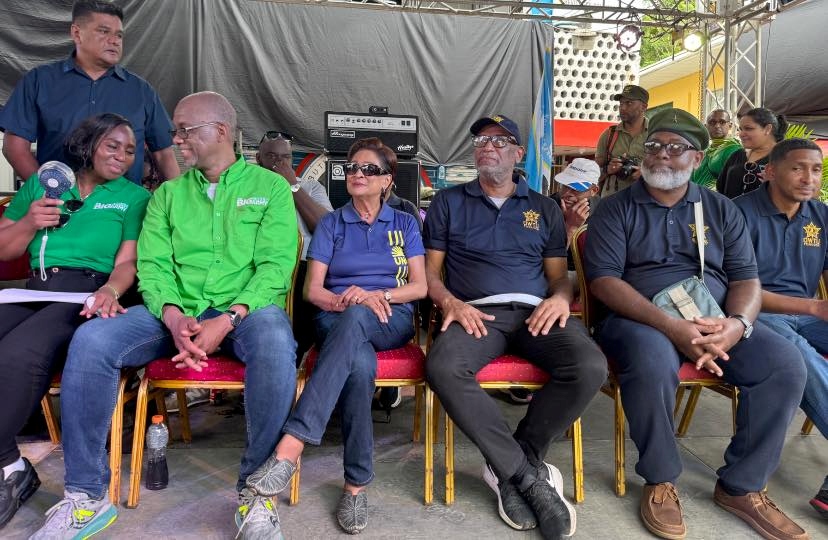Many of us remember pivotal periods that form our life‚Äôs perspective. For me, it was the late 60‚Äôs and early 70‚Äôs.¬Ý
I was a child in the Oval on 30 August 1962 when Dr Eric Williams inspired us, schoolchildren, by telling us that our future was in our schoolbags. I remember two black youths squaring off in a riveting debate—(now Bishop) Clyde Harvey, representing St Mary’s College and Queen’s Royal College’s Michael Harris.

Laventille was throbbing with life and flush with the smell of coconuts and the surfeit of citrus marking the factories that lined the Eastern Main Road. I sat in class with Carlton Layne of Paris Boulevard, a brilliant mathematician, the likes of which I did not meet until graduate school.
Desperadoes was a class act, but the classical beauty was Highlanders. I am sure nobody who heard ‘Every Valley shall be exalted’ ever forgot the magic from Bertie Marshall.
In 1970, the energy and determination to get a better life throbbed as young people gave up partying. The sound of the shouts of ‚ÄòBlack Power‚Äô was mesmerising. The articulation of the grievances was captivating. ¬Ý
By 2012, I was deeply saddened by the stigma attached to Laventille, a place I had enjoyed as a teen and young adult. Was Laventille an unmitigated hell hole with no redemptive possibilities?¬Ý
I decided to spend time understanding the issues. Here is what I found.

(Courtesy Sean Morrison/ Wired868)
The Police 2014 crime data showed that, contrary to popular belief, several areas were mainly crime-free, while others were containers of problems. This realisation led to the inevitable question of why? What are the key factors that contribute to well-being in some communities?¬Ý
Why do some communities live happy lives while others are wrecked by violent crime? What role does the family unit play versus the police, the schools and the judicial system? How do the interactions between residents contribute to good living?
I spent 2015 talking to East Port of Spain residents from George Street in the West to Morvant in the East. From the hilltop community of St Barbs to the seafront of Sea Lots. I spoke to over 400 residents, including two Local Government councillors. I visited the garrisons of Kingston and the inner city communities of Cleveland, Ohio, USA, to draw comparisons.¬Ý

(Copyright Johanne Rahaman via phmuseum.com)
The first thing to be accepted is that the neat linear approach to problem-solving cannot solve these social problems. They are ‚Äòwicked‚Äô‚Äîyou cannot tackle one piece without affecting another. There are no quick ‚Äòfixes‚Äô or ‚Äòright and wrong‚Äô answers.¬Ý
Unfortunately, they are aggravating and stubbornly resistant to egotistical men. Stakeholders often cannot agree on the nature of the problem being tackled. But rather than have a desire to listen and learn, they rush to conclusions since they are convinced of their superior understanding.¬Ý
This thinking leads to finger-pointing and believing that the chaos seen is due to incompetence or poor leadership. This mindset removes the potential to exercise collective intelligence about how to solve it.¬Ý
The Anthony Watkins-led committee understood this challenge in their community consultations. Sadly, the national population did not gain any insights from the learnings of that team. Public presentations could have galvanised national opinion, leading to more informed analyses. ¬Ý

(via Dr Keith Rowley)
Secondly, hopelessness pervades those areas with high crime. The fear of crime knocking on their doors and the poor police response lead businesses and families to leave.¬Ý
‚Äú‚Ķ Law enforcement agencies are not well-respected‚Ķofficers are crooked as a snake‚Ķ who have their price‚Ķ who supply boys with bullets‚Ķ rent out weapons.¬Ý
“Our good people, law-abiding citizens, do not necessarily trust the police at all… that just perpetuates crime because nobody reports everything anymore….”
A youth reported, “… that day, the police made me feel like killing them… because I came and saw my brethren lying down there, and he wasn’t in anything… not a criminal or anything. He had a gunshot to the back of his head… I was sad… tears in both of my eyes…”

Both men along with a passenger were gunned down moments later by police officers on 27 June 2020.
The departures of businesses and families (some moved by the ruling party) result in a sense of desolation settling over the neighbourhoods. Other families withdraw from all neighbourhood activities, planning their exit.
Negative talk grows, becoming more integrated into lives of pain and often violent death. Many young men give up on life and accept death as an inevitable part of life. ¬Ý ¬Ý
“I want to leave here all now. I’ll be sitting here now…and if somebody offers me a house out of here, I gone…as God is my witness… now, now, now I gone… right now….”
But in the community that is doing well, the sentiment is different.

(Courtesy Sean Morrison/ Wired868)
“It may not be a rich community, it may be a socially deprived one, but it is still a community. There are still people who genuinely love and care for each other. That makes me feel it is okay to live here even though I am 29 years and probably qualified now to move out and get my own apartment somewhere else… but I do not see the need to do so… I already exist as a good person.”
It is not that these communities did not have or remember proud moments‚Äîthey do, and they long for their return. ¬Ý
The content of conversations matters. In the crime-plagued communities, there is the presence of deficit discourse. This narrative describes one‚Äôs life as inferior to others and places the responsibility for the quality of life on the individual without reference to the systemic problem.¬Ý

(Copyright Trinidad Express)
This creates a sense of hopelessness that allows the national community to stereotype the individuals from the district. Persons accepting the stigma give up. Several turn to a life of crime.
Stigma is a damning thing, regardless of whether your neighbourhood is crime-ridden.¬Ý
‚ÄúWell, (community A) has a sort of stigma. If you are applying for a job, you better put (a neighbourhood outside) as your address‚Ķ The first paper going in the trash is the one with the (community A) address.‚Äù¬Ý
“When I purchased that house… the bank did not want to give me a loan because the first thing they tell me is that I am living in (Community C). It did not matter that I was banking with them ever since I know myself….”

(Copyright Daily Record)
I interviewed a young woman, a qualified accountant in a major conglomerate‚Äôs head office. She was scared when I reached out to her since she had never told anyone of her upbringing. She only spoke with me because I offered the name of a confidant and complete confidentiality.¬Ý
We have two types of graduates from the hills of Laventille. Some boast of their past as a form of street cred but never help their former community. Then others scrub all references of their history. Few successful ones stand up for their community. This type of behaviour perpetuates the stigma.¬Ý
In the communities that do well, there is a vocabulary of hope as they focus on possibilities.¬Ý ¬Ý
The big difference in good living is the role of community groups and leaders. These leaders and the activities of the groups lend to the unfettered use of public spaces.¬ÝThey agitate and ensure that the streets are cleaned, and garbage is frequently hauled away. They provide creative outlets and positive role models.¬Ý

Rudder grew up in Laventille.
The presence outdoors of the elders contributes to the community’s capacity to supervise the young and engage them in profitable activities. Once only a few control the streets, the decline steps in. Gangs are disintegrative to a community.
“… The elders’ mission is to network the community and stem the losses, whether cultural, social and organisational. The various kinds of losses a community can face stem it so, at the end of the day, the children get to know the history….”
The existence of dilapidated buildings robs the communities of life. While family life can significantly contribute to communal well-being, it is undermined by the buildings in which they live and the lack of freedom to use the public space.¬Ý
When the police are erratic in their approach, resentment gives birth to anger, causing a loss of freedom to use public spaces.

(via Stabroeknews)
In 2016, I wrote about the opportunity for government to acquire and consolidate the ownership of the empty lots. The effort can lead to the development of prime property and residential housing. It would remove the sight of blighted structures, giving hope and pride.¬Ý
The garbage removal has to work. The communities must be respected.¬Ý
Government and private sector funds, coupled with this energetic community‚Äôs technical skills and innovation, can help transform unproductive national and private security expenditure into productive energy.¬Ý
The hope of long-term jobs is a most potent anti-crime initiative. The Fernandes Industrial Compound on the eastern boundary is a successful example of what is possible. It is a visionary cluster of businesses operating in a collaborative, interconnected setting enabled by excellent security.¬Ý

The companies are all there by choice. Why not in the rest of Laventille?¬Ý
Where is our imagination? Let us come together and dream of new possibilities in Laventille.

Noble Philip, a retired business executive, is trying to interpret Jesus’ relationships with the poor and rich among us. A Seeker, not a Saint.
 Wired868 Wired868 for smart sport news and opinion
Wired868 Wired868 for smart sport news and opinion






